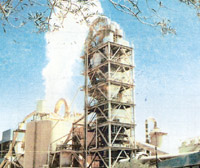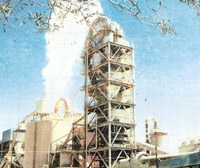
Amran Cement Factory [Archives:2001/16/Business & Economy]
April 16 2001
Hassan Al-Zayidi
Yemen Times


In the year 2000 the Amran Cement Plant achieved profits estimated at 4 billion rials. Salaries of workers have also remarkably increased. The lowest salary a worker receives in the plant today is 45,000 thousand (US$ 271) plus residence for him/her and his/her family and health security. Mr. Dwaid said that this created problems with the government. However, they seem to ignore the amount of profits that comes when more attention is paid to the workers. He added that 65% of the surplus goes to the government which also levies a 35% tax for operating the plant and 5% tax for stone quarries.
Features & Objectives of Second Five-Year Plan
The total governmental investments in the second five year plan 2001-2005 in Yemen estimated at about YR 1 trillion. This will be spent on infrastructure projects, mainly oil, roads, ports, airports, electricity, water and sanitation, telecommunication, education and technical training.
Sources in the Ministry of Planning and Development indicate that the second five year plan aims at creating a conducive atmosphere to attract Arab and foreign investment, re-arranging roles of establishments affiliated to the authority in the economy, extending activities of the private sector in operating, administrating and maintaining some public institutions, and investing in the exporting industries.
Objectives of the Plan:
The second five-year plan aims at achieving major growth in the economic development rate, creating more job opportunities, developing the local resources through supporting agricultural production, making use of the marine wealth, and increasing production in the transferable industries to make available products for exports.
Estimations of the financial resources to fund investments in the five-year plan run to 817.8 billion. 100 billion by the private sector. 121 billion by the state and 207 billion as loans from Arab organizations and foreign countries.
Desired Economic Development Rate:
Sources in the Ministry of Planning indicate that of the objectives of the upcoming five-year plan 2001-2005 is to achieve not less than 5% development rate annually in the gross domestic product (GDP). Also to curb poverty and relieve its impact on poor sections of the society (up to 20% of the population). This can be achieved through temporary cash aids. The plan also aims at creating new job opportunities, while increasing the efficiency of production and operation rates. This will solve the problem of unemployment and slash it from 35% to less than 20% by the year 2005.
Debts Cut off:
The second five-year plan is focusing on cutting off Yemen’s foreign debt to less than 60% by the end of 2005. Especially as the government could, through the first five-year plan 1996-2000, reduce the size of foreign debt from 121% to 68% out off local products. Local debt was also reduced from 74% to less than 13%.
Improving Investment Environment:
The second five-year plan is concentrating on the establishment of a modern Yemen through completing infrastructure projects which the private sector can not fund. Road to facilitate transportation, dams to supply water to agriculture, marine wealth development, and high voltage stations are all essentials for improving the investment environment.
Activating Financial Policy:
Financial policies in the second-five year plan tend to rely on the active use of the financial and monetary policies and tools to re-store the economic and financial balance. This is made with the objective to address the disequilibrium pertaining to inflation, deficit of the state, trade balance in accordance with the market based economy liberating prices from any administrative restraints. The private sector has to play its role in terms of increasing production and investment.
The plan also focuses on tackling conditions of the public sector through implementing of a well-planned privatization program, aiming at increasing public revenues.
With the second five-year plan the government seeks to pave the way to increase investment in the private sector, facilitate the influx of Arab and foreign capital and mobilize them in the various economic fields in the country.
——
[archive-e:16-v:2001-y:2001-d:2001-04-16-p:./2001/iss16/b&e.htm]


